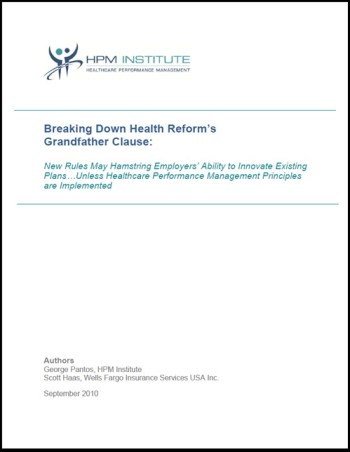Healthcare Mergers: An Emerging Crisis

Johns Hopkins Medicine, for instance, is snapping up hospitals in the Washington, D.C.-area, a move it describes as “driven largely by health care reform, which demands an integrated regional network.”
Johns Hopkins is not alone. Many established actors in the health care industry – including insurers, brokers and providers – are searching for ways to increase their market clout.
That’s bad news for ordinary patients, who will be forced to pay ever more for their care as the level of competition in the health care marketplace dwindles.
It’s easy to see why competition drives down costs. When insurers or health care providers have to battle one another to attract customers, they must differentiate themselves by charging lower prices or providing better service.
But if an insurer dominates a marketplace, it can raise prices and lower service standards with impunity.
Many insurers and providers are already taking steps to limit competition. Consider ‘most favored nation’ (MFN) clauses, which insurers use to prohibit hospitals or doctors from charging competitors less. Insurers claim that these discounts are necessary to help them secure the best possible deal.
Unfortunately, it’s the “best possible deal” for the insurer — not ordinary patients. The ‘low’ prices included in these MFN clauses are often based on artificially high price quotes from the provider. In some cases, insurers have actually agreed to increase what they’ll pay so long as other insurers are forced to pay even more.
Patients, of course, lose. The favored insurer passes along artificial cost increases directly to their customers, while disadvantaged competitors have to charge even higher premiums to continue offering access to offending providers. Many insurers simply exit a market once a rival negotiates an MFN.
Such an exit can be disastrous. According to an American Medical Association study, two or fewer health insurers control more than 70 percent of the market in 24 states. And if a competitor is foolhardy enough to try to work around an MFN, then the dominant insurer can simply force its rival out of the market.
A case in point is TheraMatrix, a small Michigan company. In 2005, TheraMatrix contracted with Ford Motor Co. to provide physical therapy services to its employees. TheraMatrix cut Ford’s costs by nearly half – saving the company millions of dollars. Last year, Ford expanded the program to cover 390,000 employees and retirees nationwide.
Everyone was happy – except Blue Cross Blue Shield of Michigan (BCBSM), which handled the administrative side of Ford’s insurance plan.
As TheraMatrix added other automakers to its customer base, BCBSM dropped the company from its medical provider network, which covers most Michiganians. BCBSM also threatened to revoke its other customers’ hospital discounts if they carved out their physical therapy benefits and contracted with TheraMatrix to provide them.
Blue Cross wrote that TheraMatrix’s operations were “competitive and damaging not only to BCBSM’s financial interests, but also to its business relationships.”
In other words, BCBSM would not allow its customers to shop around for better deals. And it would try to bully TheraMatrix out of business.
Such anti-competitive behavior harms employers and patients alike. Further consolidation of insurers and providers could make things worse.
Over the last 10 years, employer-provided health insurance premiums have more than doubled. Premiums for the most popular employer-provided plans are projected to increase by another 10 percent next year.
If businesses are to stop runaway medical costs, they’ll have to take control of their benefits. They can do so with the help of a new business strategy: ‘Healthcare Performance Management’ (HPM).
HPM uses powerful software to show companies where their health plan dollars are going, and where opportunities for savings exist.
For instance, HPM analysis of employee medical and prescription claims data might show that a company is spending too much on brand-name prescription drugs and that alternatives like generics could help it save millions.
Unsurprisingly, insurers don’t want to share this data with businesses. After all, if a company can’t pinpoint exactly how it’s spending its health dollars, it will be less likely to question premium hikes. Nor will it be able to find efficiencies, as Ford did, by cutting the insurer middleman out of the equation.
In many parts of the country, big health insurers have enjoyed virtual monopolies. Unburdened by real competition, they’ve abused their powers while businesses and their employees footed the bill.
HPM empowers businesses to inject competition into the healthcare marketplace and fight back against decades of cost increases. Employers should take advantage.
Additional Information
In addition to the invaluable insights George shares in this StrategyDriven Editorial Perspective article are the resources accessible from his website, www.HPMInstitute.org. George can be reached at [email protected].
Final Request…
The strength in our community grows with the additional insights brought by our expanding member base. Please consider rating us and sharing your perspectives regarding the StrategyDriven Editorial Perspective podcast on iTunes by clicking here. Sharing your thoughts improves our ranking and helps us attract new listeners which, in turn, helps us grow our community.
Thank you again for listening to the StrategyDriven Editorial Perspective podcast!
About the Author


 New Rules May Hamstring Employers’ Ability to Innovate Existing Plans…
New Rules May Hamstring Employers’ Ability to Innovate Existing Plans… StrategyDriven Editorial Perspective podcasts examine the unnecessary marketplace uncertainty created by today’s headline events and the actions business leaders should take to ensure their organizations succeed under these circumstances.
StrategyDriven Editorial Perspective podcasts examine the unnecessary marketplace uncertainty created by today’s headline events and the actions business leaders should take to ensure their organizations succeed under these circumstances.